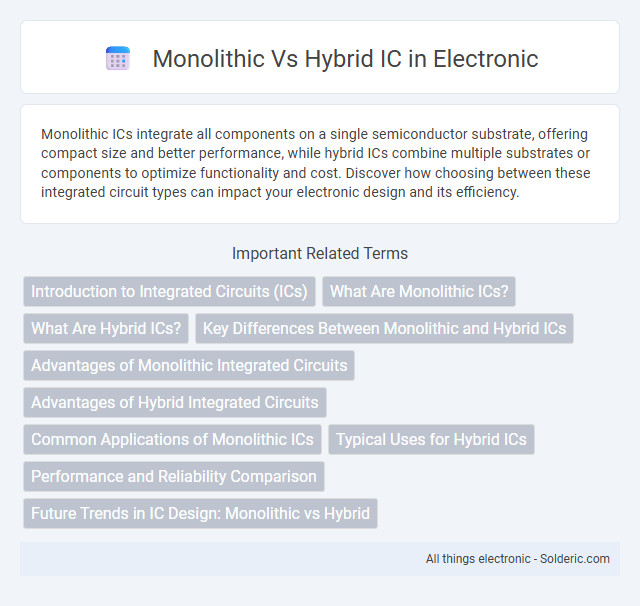Monolithic ICs integrate all components on a single semiconductor substrate, offering compact size and better performance, while hybrid ICs combine multiple substrates or components to optimize functionality and cost. Discover how choosing between these integrated circuit types can impact your electronic design and its efficiency.
Comparison Table
| Feature | Monolithic IC | Hybrid IC |
|---|---|---|
| Definition | Single substrate integrating all components | Combination of discrete components on a single substrate |
| Manufacturing | Fabricated through photolithography on semiconductor wafers | Combines thin/thick film technologies and discrete parts assembly |
| Size | Compact, small footprint | Larger due to discrete component integration |
| Performance | High-speed, low parasitics, better reliability | Moderate speed, higher parasitics, variable reliability |
| Cost | Cost-effective for high volume production | Higher cost due to assembly and materials |
| Flexibility | Limited to photolithographic design constraints | Greater flexibility in component choice and customization |
| Applications | Consumer electronics, microprocessors, memory chips | Specialized circuits, RF modules, sensors |
| Thermal Management | Integrated heat dissipation | Requires additional thermal solutions |
Introduction to Integrated Circuits (ICs)
Integrated Circuits (ICs) are semiconductor devices that integrate multiple electronic components onto a single chip, enabling compact and efficient circuit designs. Monolithic ICs consist of all components fabricated on a single silicon substrate, offering high performance, reliability, and cost-effectiveness for mass production. Hybrid ICs combine separate components and substrates into a single package, allowing customization and the integration of diverse materials for specialized applications.
What Are Monolithic ICs?
Monolithic ICs are integrated circuits where all components, such as transistors, resistors, and capacitors, are fabricated on a single semiconductor substrate, typically silicon. This design offers high reliability, reduced parasitic effects, and compact size, making Monolithic ICs ideal for mass production in applications like microprocessors and memory chips. Your choice of Monolithic IC ensures efficient performance and cost-effective manufacturing in electronic devices.
What Are Hybrid ICs?
Hybrid ICs combine multiple discrete components, such as resistors, capacitors, and semiconductors, mounted on a ceramic or organic substrate to create a compact and reliable circuit. Unlike monolithic ICs, which are fabricated entirely on a single semiconductor wafer, hybrid ICs allow integration of distinct technologies and component types for enhanced performance and customization. These circuits are widely used in aerospace, medical devices, and RF applications where high reliability and precision are critical.
Key Differences Between Monolithic and Hybrid ICs
Monolithic ICs integrate all components, including transistors, resistors, and capacitors, onto a single semiconductor substrate, offering higher reliability and lower manufacturing costs. Hybrid ICs combine multiple discrete components and substrates on a ceramic or other insulating base, providing greater design flexibility and the ability to use specialized materials. The primary differences lie in fabrication techniques, size, performance consistency, and cost-effectiveness, with monolithic ICs favoring mass production and hybrid ICs suiting custom or high-power applications.
Advantages of Monolithic Integrated Circuits
Monolithic Integrated Circuits (ICs) offer significant advantages including enhanced reliability due to fewer interconnections and reduced parasitic capacitances. Their compact size leads to improved performance and cost-efficiency in mass production, making them ideal for high-volume applications. You benefit from faster signal processing and lower power consumption compared to hybrid ICs, ensuring efficient and scalable electronic designs.
Advantages of Hybrid Integrated Circuits
Hybrid Integrated Circuits (ICs) offer enhanced design flexibility by combining different semiconductor technologies and components on a single substrate, enabling high-performance customization. They provide superior reliability and durability, making them ideal for demanding applications such as aerospace and medical devices. Your projects benefit from improved thermal management and reduced parasitic elements, leading to optimized circuit performance and longevity.
Common Applications of Monolithic ICs
Monolithic ICs are widely used in consumer electronics such as smartphones, digital cameras, and audio equipment due to their compact size and cost-effectiveness. They play a crucial role in power management circuits, microprocessors, and memory devices, where integration and reliability are paramount. Industrial automation and automotive control systems also leverage monolithic ICs for precise sensor interfacing and signal processing.
Typical Uses for Hybrid ICs
Hybrid ICs are commonly utilized in aerospace, medical devices, and military applications due to their ability to integrate diverse components, including semiconductors, passive elements, and sensors, on a single substrate. These circuits offer superior reliability and performance in harsh environments where monolithic ICs might fail. Their typical uses include radar systems, implantable medical devices, and precision instrumentation requiring customized, high-density packaging.
Performance and Reliability Comparison
Monolithic ICs typically offer superior performance due to their high integration density, reduced parasitic capacitance, and shorter interconnects, enabling faster signal processing and lower power consumption compared to Hybrid ICs. Hybrid ICs provide enhanced reliability under extreme environmental conditions by combining different substrate materials and discrete components, which resist thermal and mechanical stresses better than monolithic ICs. The trade-off involves Monolithic ICs excelling in speed and efficiency, while Hybrid ICs deliver robustness and durability for specialized applications.
Future Trends in IC Design: Monolithic vs Hybrid
Future trends in IC design emphasize increased integration and advanced manufacturing techniques, with monolithic ICs benefiting from smaller process nodes and enhanced performance due to unified silicon fabrication. Hybrid ICs continue to evolve by integrating heterogeneous materials and components like sensors, optics, and power devices, enabling multifunctional systems that monolithic ICs alone cannot achieve efficiently. Innovations such as 3D packaging, system-in-package (SiP) technologies, and advanced heterogeneous integration platforms drive the convergence of monolithic and hybrid design advantages for next-generation electronics.
Monolithic vs Hybrid IC Infographic

 solderic.com
solderic.com